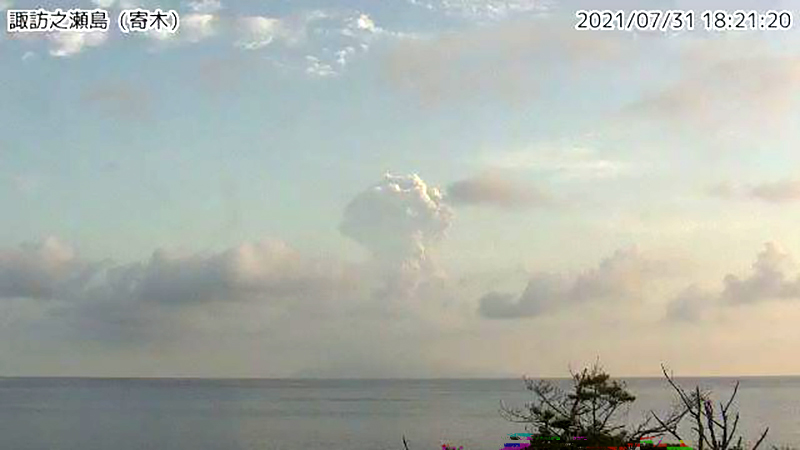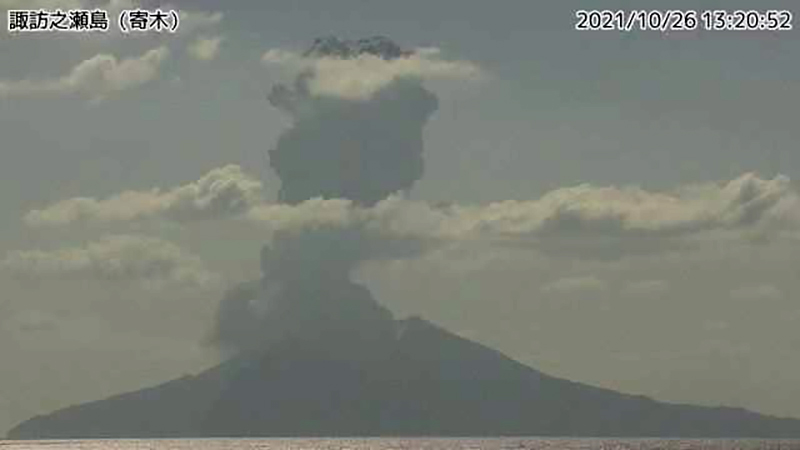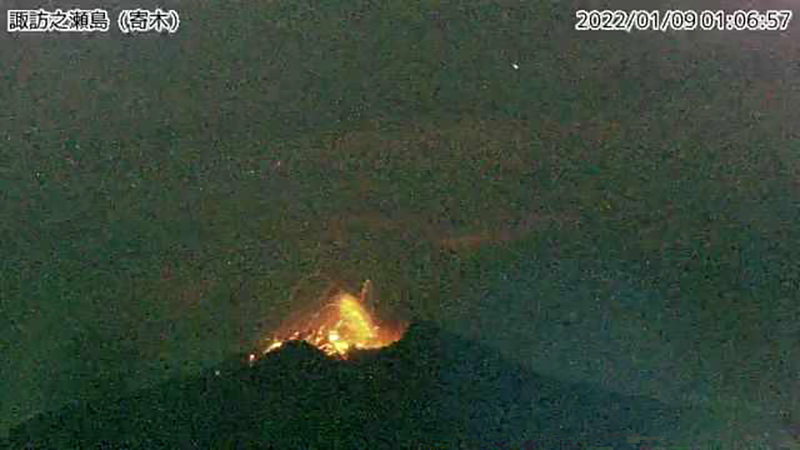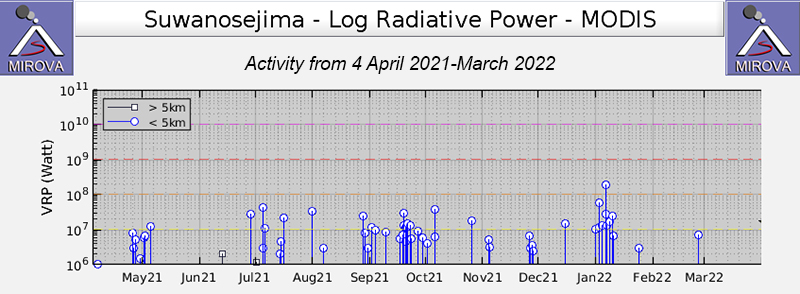Report on Suwanosejima (Japan) — April 2022
Bulletin of the Global Volcanism Network, vol. 47, no. 4 (April 2022)
Managing Editor: Edward Venzke.
Edited by Kadie L. Bennis.
Suwanosejima (Japan) Frequent explosions with ash plumes and ejecta
Please cite this report as:
Global Volcanism Program, 2022. Report on Suwanosejima (Japan) (Bennis, K.L., and Venzke, E., eds.). Bulletin of the Global Volcanism Network, 47:4. Smithsonian Institution. https://doi.org/10.5479/si.GVP.BGVN202204-282030
Suwanosejima
Japan
29.638°N, 129.714°E; summit elev. 796 m
All times are local (unless otherwise noted)
Suwanosejima is an 8-km-long island located in the northern Ryukyu Islands, Japan, consisting of a stratovolcano and two historically active summit craters. Volcanism was intermittent for much of the 20th century, characterized by Strombolian explosions, ash plumes, and ashfall. The current eruption began in October 2004 and has recently consisted of intermittent explosions, ash emissions, and incandescent ejecta (BGVN 46:09). Incandescence is often observed at night and ejecta periodically reaches as far as a kilometer from the summit. Ashfall is usually noted several times each month in the nearby community on the SW flank of the island. This report covers activity from July 2021 through March 2022 using information from the Japan Meteorological Agency (JMA), the Tokyo Volcanic Ash Advisory Center (VAAC), and several sources of satellite data.
Intermittent explosions were detected in the Otake crater, generating ash plumes that rose 5.4 km above the crater rim. Larger volcanic bombs were ejected as far as 1.9 km from the crater. Crater incandescence was frequently visible at night. The MIROVA Log Radiative Power graph of the MODIS thermal anomaly data through March 2022 indicates intermittent pulses of increased thermal activity in in late April to early May 2021, July 2021, September 2021, two small pulses in early and late November 2021, and early January 2022 that appear to correspond to increased periods of explosive activity (figure 67). According to data from the MODVOLC thermal algorithm, a total of eight hotspots were detected: one on 29 August, one on 10 September, two on 21 September, one on 23 September 2021, one on 4 January 2022, and two on 6 January. Reports of eruption sounds were heard in Toshima village (4 km SSW), in addition to occasional ashfall events.
Ongoing explosions during July generated ash plumes that rose 1.6-3.6 km high (figure 68). Bombs were ejected as far as 1 km from the crater, accompanied by occasional crater incandescence that was visible at night. An explosion on 8 July at 0439 ejected bombs 800 m NW. An explosion at 1319 on 12 July generated an ash plume that rose 3 km high and later at 2330 a second explosion produced an ash plume 3.6 km high. Eruption sounds were heard in Toshima village; ashfall deposits were reported in the village during 12-19 July. On 29 July JMA lowered the Volcano Alert Level to 2 (on a 5-level scale) at 1100 and warned the public to stay 1 km from the crater.
 |
Figure 68. Photo of an eruption plume rising 3.8 km high above Suwanosejima at 1814 on 31 July 2021. Courtesy of JMA (Volcanic activity commentary for Suwanosejima, July 2021). |
During August, explosions continued, producing ash plumes that rose 2.2-4.8 km high. Large blocks were ejected as far as 500 m from the crater, accompanied by nightly crater incandescence. Ashfall was occasionally reported in Toshima village. On 19 August an explosion at 0137 and 1613 produced an ash plume that rose 3 km and 2.2 km NE and N above the crater, respectively. A third explosion at 2059 generated an ash plume that rose 2.5 km above the crater and drifted N. A small amount of ashfall was reported in Yakushima, Nishinoomote, and Nakatane, as well as Toshima village. Explosions at 0628 and 0713 on 20 August produced ash plumes that rose 2.5-3 km above the crater and drifted N, resulting in ashfall in Toshima village, with smaller amounts in Yakushima, Mishima, Ibusuki, Minamikyushu, and Makurazaki. An explosion at 0617 on 21 August resulted in an ash plume 3.2 km above the crater that drifted N; a large amount of ash (over 1 mm) was detected in Toshima village and a smaller amount (less than 0.1 mm) was detected in Makurazaki, Minamisatsuma, Minamikyushu, Kagoshima, Ibusuki, and Hioki. A second explosion that day at 0906 produced an ash plume up to 3.2 km high that drifted N. On 28 August an explosion occurred at 1231 that produced an ash plume 4.8 km above the crater, though weather clouds prevented clear views of the summit.
Explosions persisted during September, with ash plumes rising 2.4-5.4 km high. Some crater incandescence was visible at night, which was also detected in Sentinel-2 infrared satellite imagery on clear weather days (figure 69). On 17 September explosions were detected at 0212 and 0218, which ejected material 1 km SE from the crater. JMA raised the Alert Level to 3 at 0235. On 20 September an explosion ejected material as far as 1.2 km SE from the crater. An eruptive event at 0711 on 26 September produced an ash plume that rose 5.4 km high, though weather clouds prevented a clear view of the summit. As a result, ejecta traveled 800 m from the crater and a large amount of ash was reported in Toshima village.
During October, frequent explosions continued, generating ash plumes up to 3.3 km high and ejecting bombs as far as 1.1 km from the crater. Occasional crater incandescence was noted at night, as well as ashfall in Toshima village. On 26 October an explosion at 1317 produced an ash plume that rose 3.3 km above the crater and ejected material was reported up to 1.9 km from the crater (figure 70). Similar activity continued in November with explosions that produced ash plumes 1.2-2.7 km above the crater. Large volcanic bombs were ejected 800 m from the crater and occasional ashfall was reported in Toshima village. During late November crater incandescence was visible nightly.
 |
Figure 70. Photo of an eruption plume rising 3.3 km above Suwanosejima at 1317 on 26 October 2021. Courtesy of JMA (Volcanic activity commentary for Suwanosejima, October 2021). |
Explosions during December generated ash plumes 1.5-3.1 km high and ejected large blocks as far as 800 m from the crater. Some ash plumes rose 1-3.4 km high in early December but were not associated with explosive events. Occasional crater incandescence was visible at night. Hundreds of explosions persisted during January 2022 with ash plumes rising 1.4-3 km high and nighttime crater incandescence. Material was ejected 1.1 km from the crater. During the latter half of the month, rumbling sounds and ashfall were reported in Toshima village.
 |
Figure 71. Photo of crater incandescence from Suwanosejima at 0106 on 9 January 2022. Courtesy of JMA (Volcanic activity commentary for Suwanosejima, January 2022). |
Similar activity continued during February and March with intermittent explosions and ash plumes rising 1.3-2.8 km high. Bombs were ejected 900 m from the crater and crater incandescence persisted. Ashfall also was also intermittently reported in Toshima village.
Geological Summary. The 8-km-long island of Suwanosejima in the northern Ryukyu Islands consists of an andesitic stratovolcano with two active summit craters. The summit is truncated by a large breached crater extending to the sea on the E flank that was formed by edifice collapse. One of Japan's most frequently active volcanoes, it was in a state of intermittent Strombolian activity from Otake, the NE summit crater, between 1949 and 1996, after which periods of inactivity lengthened. The largest recorded eruption took place in 1813-14, when thick scoria deposits covered residential areas, and the SW crater produced two lava flows that reached the western coast. At the end of the eruption the summit of Otake collapsed, forming a large debris avalanche and creating an open collapse scarp extending to the eastern coast. The island remained uninhabited for about 70 years after the 1813-1814 eruption. Lava flows reached the eastern coast of the island in 1884. Only about 50 people live on the island.
Information Contacts: Japan Meteorological Agency (JMA), 1-3-4 Otemachi, Chiyoda-ku, Tokyo 100-8122, Japan (URL: http://www.jma.go.jp/jma/indexe.html); MIROVA (Middle InfraRed Observation of Volcanic Activity), a collaborative project between the Universities of Turin and Florence (Italy) supported by the Centre for Volcanic Risk of the Italian Civil Protection Department (URL: http://www.mirovaweb.it/); Hawai'i Institute of Geophysics and Planetology (HIGP) - MODVOLC Thermal Alerts System, School of Ocean and Earth Science and Technology (SOEST), Univ. of Hawai'i, 2525 Correa Road, Honolulu, HI 96822, USA (URL: http://modis.higp.hawaii.edu/); Sentinel Hub Playground (URL: https://www.sentinel-hub.com/explore/sentinel-playground).



